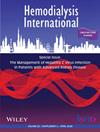Necessity of adjusting the blood hemoglobin target owing to interdialytic weight gain in patients on maintenance hemodialysis
IF 1.2
4区 医学
Q3 UROLOGY & NEPHROLOGY
引用次数: 0
Abstract
To the Editor: Anemia is a common complication in patients on maintenance hemodialysis, and its correction with erythropoiesis-stimulating agents is an established therapy. Current guidelines indicate the target blood hemoglobin levels for administering erythropoiesisstimulating agents but do not specify the hemoglobin measurement conditions, which reportedly affect hemoglobin in maintenance hemodialysis patients. Notably, hemoglobin decreases in case of hemodilution, such as that caused by interdialytic weight gain, and a difference in the gain would generally result in pre-dialysis hemoglobin measured early in the week (early-week-preHb) being lower than that measured midweek (midweekpre-Hb). However, studies examining this hemoglobin difference are scarce and have reported varying results; the difference was only 0.9% in one study but 4.3% in another. Thus, we aimed to examine this difference. This study was performed at a dialysis center in accordance with the Declaration of Helsinki. Pre-dialysis hemoglobin was measured during consecutive earlyweek and midweek maintenance hemodialysis sessions in 12 patients who were undergoing three maintenance hemodialysis sessions per week and were not on the therapy with erythropoiesis-stimulating agents. Comparisons were performed using Student’s paired t-test. Table 1 summarizes the measurements. The mean and median of the early-week-pre-Hb to midweek-pre-Hb ratio were 96.1% and 96.8%, respectively. Therefore, early-week-pre-Hb was lower than midweek-pre-Hb by approximately 4%. In the present analysis, interdialytic weight gain relative to dry weight—the target weight after a dialysis session (IDWG/DW)—was approximately 5.5% and 4.2% in the early-week and midweek sessions, respectively. This increase reduced early-week-pre-Hb by approximately 4% compared with midweek-pre-Hb. Thus, hemoglobin decreased by approximately 3% per additional 1% increase in IDWG/DW. As the daily IDWG/DW is typically 1.5%, the present findings support the previous finding that early-week-pre-Hb was lower than midweekpre-Hb by approximately 4.5%. Interdialytic weight gain is primarily attributed to increased extracellular fluid. As extracellular fluid accounts for approximately one-third of the total body fluid, which in turn accounts for approximately由于维持性血液透析患者的分析间体重增加,调整血红蛋白目标的必要性。
本文章由计算机程序翻译,如有差异,请以英文原文为准。
求助全文
约1分钟内获得全文
求助全文
来源期刊

Hemodialysis International
UROLOGY & NEPHROLOGY-
CiteScore
2.50
自引率
0.00%
发文量
58
审稿时长
6-12 weeks
期刊介绍:
Hemodialysis International was originally an annual publication containing the Proceedings of the International Symposium on Hemodialysis held in conjunction with the Annual Dialysis Conference. Since 2003, Hemodialysis International is published quarterly and contains original papers on clinical and experimental topics related to dialysis in addition to the Annual Dialysis Conference supplement. This journal is a must-have for nephrologists, nurses, and technicians worldwide. Quarterly issues of Hemodialysis International are included with your membership to the International Society for Hemodialysis.
The journal contains original articles, review articles, and commentary to keep readers completely updated in the field of hemodialysis. Edited by international and multidisciplinary experts, Hemodialysis International disseminates critical information in the field.
 求助内容:
求助内容: 应助结果提醒方式:
应助结果提醒方式:


